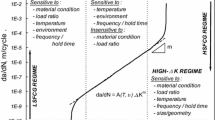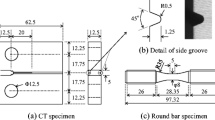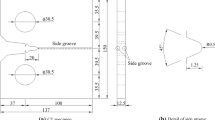Abstract
A study on a creep-fatigue crack growth behavior has been carried out for a cylindrical structure with weldments by using a structural test and an evaluation according to the assessment procedures. The creep-fatigue crack growth behavior following the creep-fatigue crack initiation has been assessed by using the French A16 procedure and the conservatism for the present structural test has been examined. The structural specimen is a welded cylindrical shell made of 316 L stainless steel (SS) for one half of the cylinder and 304 SS for the other half. In the creep-fatigue test, the hold time under a tensile load which produces the primary nominal stress of 45 MPa was one hour at 600°C and creep-fatigue loads of 600 cycles were applied. The evaluation results for the creep-fatigue crack propagation were compared with those of the observed images from the structural test. The assessment results for the creep-fatigue crack behavior according to the French A16 procedure showed that the A16 is overly conservative for the creep-fatigue crack propagation in the present case with a short hold time of one hour.
Similar content being viewed by others
References
A16, 2002, Subsection; Technical Appendix A16 of RCC-MR, “Guide for Leak Before Break Analysis and Defect Assessment,” AFCEN.
A3, 2002, Subsection Z: Technical Appendix A3, RCC-MR, AFCEN.
ABAQUS Users manual, 2005, Version 6.5, H. K.S, USA.
ASME Boiler and Pressure Vessel Code, 2004, Section III, Rules for Construction of Nuclear Power Plant Components, Div. 1, Subsection NH, Class 1 Components in Elevated Temperature Service.
British Energy Generation Ltd, 2001,Assessment of the Integrity of Structures Containing Defects, R6 Rev. 4. British Energy Generation Ltd, UK.
British Standard Institution, 2000,Guide on Methods for Assessing the Acceptability of Flaws in Metallic Structures, BS7910: 1999 (Rev. March 2000) British Standards Institution, London, UK.
Chellapandi, P., Chetal, S. C. m Raj, Baldev., 2005, “Assessment ofσ d Approach for Creep Damage Estimation of FBR Components With Crack Like Defects at Welds,”IJPVP, Vol. 82, pp. 739–745.
DDS, 1998, Structural Design Guide for Class 1 Components of Prototype Fast Breeder Reactor for Elevated Temperature Service, JAPC, Japan.
Drubay, B., Marie, S., Chpuliot, S., Lacire, M. H., Michel, B. and Deschanels, H., 2003, “A16: Guide for Defect Assessment at Elevated Temperature,”International Journal of Pressure Vessel and Piping, Vol. 80, pp. 499–516.
Hahn, D.-H. et al., 2004,KALIMER Preliminary Conceptual Design Report, KAERI/TR-2204, Korea Atomic Energy Research Institute, Daejeon.
Kim, J. B., Park, C. -G., Lee, H. -Y. and Lee, J. -H., 2005,Experiment and Analysis on the Creepfatigue Damage of 316 SS nonlinear Structure in Liquid Metal Reactor Subjected to Cyclic Loading with 1hr Hold Time, 18th Int. Conf. on Structural Mechanics in Reactor Technology, Beijing, China, August 7.
Kraus, H., Creep Analysis, 1980, John Wiley & Sons.
Lee, H. -Y and Nikbin, K. M., 2006d, “Modelling the Redistribution of Residual Stresses at Elevated Temperature in Components,”Journal of ASTM International, Vol. 3(1), pp. 1–15.
Lee, H. -Y., Biglari, F., Wimpory, R., O’Dowd, N. P., Nikbin, K. M., 2006b, “Treatment of Residual Stresses in Life Assessment Procedures,”Engineering Fracture Mechanics, Vol. 73, pp. 1755–1771.
Lee, H. -Y., Kim, J. -B., Kim, S. -H. and Lee, J. -H, 2006a, “Assessment of Creep-Fatigue Crack Initiation for Welded Cylindrical Structure of Austenitic Stainless Steels,”International Journal of Pressure Vessel and Piping, in press, April.
Lee, H. -Y., Kim, J. -B. and Lee, J. -H., 2004, “Evaluation of Progressive Inelastic Deformation for the Welded Structure Induced by Spatial Variation of Temperature,”International Journal of Pressure Vessel and Piping, Vol. 81(5), pp. 433–441.
Lee, H. -Y., Kim, J. -B. and Lee, J. -H., 2003, “Progressive Inelastic Deformation Characteristics of Cylindrical Structure with Plate-to-shell Junction Under Moving Temperature Front,”Korean Society of Mechanical Engineering International Journal, Vol. 17(3), pp. 403–411.
Lee, H. -Y., Kim, J. -B. Lee, J. -H. and Nikbin, K. M., 2006c, “Comprehensive Residual Stress Distribution for a Plate and Pipe Components,”Journal of Mechanical Science and Technology, Vol. 20, No. 3, pp. 335–344.
RCC-MR, 2002, Design and Construction Rules for Mechanical Components of FBR Nuclear Islands, Edition 2002, AFCEN.
Author information
Authors and Affiliations
Corresponding author
Rights and permissions
About this article
Cite this article
Lee, HY., Kim, SH., Lee, JH. et al. Creep-fatigue crack growth behavior of a structure with crack like defects at the welds. J Mech Sci Technol 20, 2136–2146 (2006). https://doi.org/10.1007/BF02916330
Received:
Revised:
Issue Date:
DOI: https://doi.org/10.1007/BF02916330




